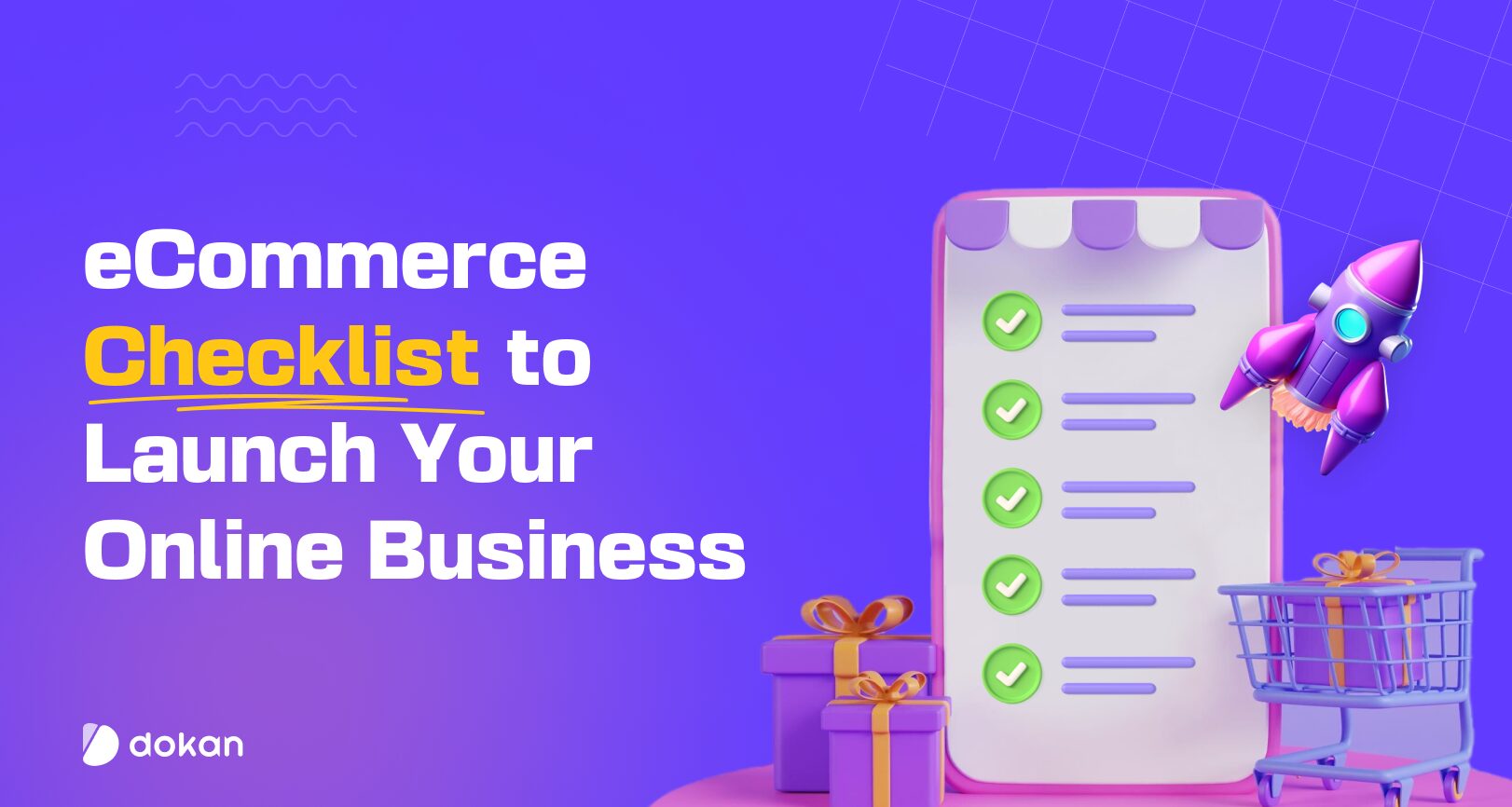The rise of online shopping has made the eCommerce space both trendy and fiercely competitive.
Let me share my friend Sarah’s story.
She noticed a rising trend in eco-friendly products and started an online store selling sustainable household items. She was passionate and had great products but unfortunately lacked preparation. Sarah quickly realized that, without a solid plan, her business was just another drop of water in the ocean.
Starting an eCommerce business involves more than setting up a website and listing products. It requires thorough preparation and effective planning.
An eCommerce checklist can be your first strategic move to navigate this complex landscape.
To ensure you cover all the bases and don’t end up like Sarah, we’ve compiled a detailed eCommerce checklist in this blog.
Why Do You Need an eCommerce Checklist for Your Online Business?
In 2023, eCommerce made up 19.5% of global retail sales. Experts predict that eCommerce sales could reach 23% of retail sales worldwide in 2027.

As you can see, eCommerce business is booming, and this upward trend shows no signs of slowing down.
If you want to join this growing industry, you need the right plan.
Let’s start with the eCommerce checklist.
An eCommerce checklist is a comprehensive list of tasks and considerations for launching and running a successful online business. It helps you:
- Set specific goals and milestones for your business
- Organize and plan each aspect of your eCommerce business
- Identify potential risks and challenges early in the process
- Prioritize tasks, allocate resources effectively, and track progress
- Take care of business compliance and legal requirements
- Keep every team member aligned with the overall objectives and timelines
In short, with a complete checklist, you can easily see what you’ve already done, what’s in progress, and what needs to be done next.
Key Elements of the eCommerce Checklist
To give you a better idea, here are some crucial elements that should be present on the top of your eCommerce checklist:
- Market Research: Understand your target audience, their needs, and your competitors.
- Business Plan: Outline your business model, revenue streams, and financial projections.
- Legal and Administrative Setup: Register your business, prepare legal documents, and set privacy policies.
- Product Selection: Choose products that have demand and align with your brand.
- Website Development: Invest in a professional, user-friendly website with solid security features.
- Logistics: Plan for inventory management, shipping, and returns.
- Marketing Strategy: Develop a plan for SEO, social media, email marketing, and paid ads.
- Customer Service: Set up a system to efficiently handle customer inquiries, complaints, and feedback.
- Launch Preparation: Check all the setups and go for last-minute promotions.
- Post-Launch Activities: Track all the activities, identify the scopes for improvements, and update the plan accordingly.
Below, we’ve explained each point of the eCommerce checklist in detail.
By going through these points, you can create a customized checklist based on your specific needs and requirements.
🤔 Ever wondered why some eCommerce dreams crash and burn while others soar to new heights? 🚀 We answer all these questions in our blog- why eCommerce businesses fail & how to resolve Them.
A Winning eCommerce Checklist to Launch a Successful Online Business
A well-optimized checklist ensures that everything is noticed and all essential steps are completed before and after launching the eCommerce venture.
First, check all the steps we’ve covered here. Then, pick the points that apply to your business and prepare a personalized checklist.
Your customized checklist will help you stay on track and review the process.
Let’s get into the details ⤵️
1. Market Research

This is the first step of any eCommerce business.
A thorough market research helps you understand your customers, competitors, and market trends. It’s like taking a snapshot of where you are before deciding where to go.
Identify Your Niche
Determine the specific market segment you want to target. This will help you choose your products and marketing strategies effectively.
Understand Your Target Audience
- Identify Your Customers: Know who will be buying your products. Are they teenagers, young professionals, parents, or retirees? What are their interests and preferences?
- Research Their Needs: Conduct surveys, read customer reviews, and engage with potential customers on social media to understand what they want in products.
- Create Buyer Personas: Craft detailed profiles of your ideal customers, including their demographics, preferences, and purchasing behaviors.
Analyze Your Competitors
- Identify Competitors: Look at businesses offering similar products. These can be direct competitors or companies in your related niches.
- Study Their Strategies: Study your competitors to understand their strengths and weaknesses. Identify gaps in the market that your business can fill.
2. Business Plan
Once you set your target audience and complete your competitors’ SWOT analysis, it’s time to build a solid business plan.
Outline Your Business Model
- Choose Revenue Streams: Decide whether you’ll operate as a Business-to-Business (B2B), Business-to-Consumer (B2C), or Consumer-to-Consumer (C2C).
- Select Your Sales Channels: Determine where you’ll sell your products. It might be through your website, third-party platforms like Amazon or eBay, social media channels, or a combination.
- Decide on Self-Hosted vs. Hosted Platforms: Choose between self-hosted platforms (like WooCommerce or Magento) or hosted platforms (such as Shopify or BigCommerce).
A quick overview: Self-hosted platforms offer more customization but require technical expertise, while hosted platforms are easier to set up and manage.
Create Financial Projections
- Estimate Expenses and Revenue: Calculate your startup costs, ongoing expenses, and projected income. Include costs for website development, inventory, marketing, and shipping.
- Plan for Profits and Losses: Prepare for initial losses and plan for reaching profitability.
3. Legal and Administrative Setup

Next, you should prepare all the legal documentation and perform all the administrative tasks. This will protect you and your customers from any unpleasant occurrences.
Business Registration
- Choose a Business Name: Pick a unique, memorable, and relevant name for your online store.
- Register Your Business: Register your business entity (sole proprietorship, partnership, LLC, corporation) with the appropriate government authorities. Obtain necessary permits and licenses to operate legally in your jurisdiction.
Legal Considerations
- EIN: Apply for an Employer Identification Number (EIN) if you’re in the US.
- Business Structure: Decide on a business structure (sole proprietorship, LLC, corporation) that best suits your needs.
- Trademark: Consider trademarking your business name and logo to protect your brand.
- Research Regulations: Understand and comply with eCommerce laws, including consumer rights, data protection, and online business regulations.
Create Privacy Policies and Terms of Service
- Clear Policies: Draft clear privacy policies and terms of service to protect your business and inform customers of their rights.
- Prominent Display: Place these policies in an easily accessible location on your website. (Once you live your website)
4. Product Selection

A quality product or service is a cornerstone of your eCommerce business because it keeps customers satisfied and returning for more. You can only survive in this competitive world by providing quality products.
Choose In-Demand and Trendy Products
- Research Trends: Use tools like Google Trends, social media, and industry reports to identify popular products.
- Customer Feedback: Listen to customers’ comments about current products and potential improvements.
Align Products with Your Brand
Ensure your products fit your brand’s values and image. For example, if your brand promotes sustainability, focus on eco-friendly products.
On the other hand, a brand dedicated to health and wellness should offer products like organic food items, fitness gear, or natural supplements.
A quick suggestion for aspiring entrepreneurs: Avoid products with no market demand or have too much competition. Instead, aim for products that align with your passions, fill a market need, and offer growth potential.
5. Website Development
After performing all these tasks, you must invest in creating a professional website to sell your products. A well-optimized website gives you solid online visibility, enabling you to run a successful eCommerce business.
Choose an eCommerce Platform
Get a platform like Shopify, WooCommerce, BigCommerce, or Magento based on your needs and technical expertise.
To select a suitable eCommerce platform you can check this blog on the best CMS platforms comparison.
Create Website
- Domain Name: Register a domain name that reflects your business name.
- Web Hosting: Choose a reliable hosting service if you’re using a self-hosted platform.
- Design and Layout: Select a responsive theme or hire a web designer to create a professional and user-friendly layout.
- Essential Pages: Create mandatory pages such as Home, Shop, About Us, Contact, FAQ, and Privacy Policy.
- Hire a Web Developer: If needed, hire a professional to build a high-quality, secure website.
Product Listings
- Product Descriptions: Write compelling and detailed descriptions for each product.
- High-Quality Images: Use professional photos that showcase your products from multiple angles.
Design a Professional UI/UX
- Navigation: Ensure easy navigation with clear categories and search functionality.
- Mobile Optimization: Ensure your website works well on mobile devices.
Ensure Strong Security Features
- SSL Certificate: Ensure your site is secure with an SSL certificate to protect customer data.
- Protect Customer Data: Use SSL certificates and secure payment gateways to protect customer information.
- Include a Secure Payment Gateway: Set up payment gateways to process online transactions securely. Choose reputable payment service providers that comply with industry standards for data security (PCI DSS).

Subscribe to
Dokan blog
6. Logistics
Efficient logistics ensure that products reach customers on time and in good condition. It contributes to customer satisfaction and repeat business.
Plan Inventory Management
- Inventory Management: Implement an inventory management system to keep track of stock levels.
- Track Stock Levels: Use inventory management software to monitor stock levels and avoid overstocking or running out of products.
Set Price and Tax Regulation
- Pricing Strategy: Define how you’ll price your products. You can choose competitive pricing, premium pricing, or value-based pricing. Consider factors like production costs, competitor prices, and others.
- Sales Tax: Configure your store to collect the appropriate sales tax based on your location and where you ship.
Organize Shipping
- Reliable Shipping Partners: Choose shipping companies known for reliability and reasonable rates.
- Shipping Policies: Define your shipping policies, including costs and delivery times.
- Shipping Options: To accommodate different customer needs, offer multiple shipping options, such as standard and expedited shipping.
Handle Returns & Refunds
- Clear Return Policy: Provide a straightforward return policy that details the process for returning items.
- Easy Returns: Make it easy for customers to return products, such as providing return labels and hassle-free packaging.
7. Marketing Strategy

With a solid marketing strategy, you can identify the most effective channels to reach your audience, engage with your target audience, and drive sales.
Here is what you need to build a strong marketing strategy for your eCommerce business:
Do Branding
- Brand Identity: Develop a strong brand identity with a logo, color scheme, and consistent messaging.
- Social Media Presence: Set up profiles on relevant social media platforms and create a content calendar.
Expert Tip: Share user-generated content and run contests to boost engagement.
Develop an SEO Strategy
- Keyword Research: Identify and integrate relevant product keywords into your website content.
- Content Creation: Regularly update your blog with informative posts about your products.
Leverage Email Marketing
- Build an Email List: Collect emails through sign-up forms, lead magnets, and purchase data.
- Regular Updates: Send your subscribers newsletters, promotional offers, and product updates.
Invest in Paid Ads
- Targeted Advertising: Use platforms like Google Ads and Facebook Ads to reach your specific audience.
- Budget Management: Set a budget and monitor your ad performance to ensure a good return on investment.
8. Customer Service
Excellent customer service can help resolve issues quickly, answer questions, and create a positive shopping experience. It’s undoubtedly a crucial part of your eCommerce checklist.
Set Up a Customer Service System
- Helpdesk Software: Use tools like Zendesk or Freshdesk to manage customer inquiries efficiently.
- Multiple Contact Options: Provide several ways for customers to reach you, including email, phone, and live chat.
- Quick Responses: Aim to respond to customer questions and complaints within 24 hours.
Arrange Customer Engagement Events
- Loyalty Programs: Create a loyalty or rewards program to retain customers.
- Customer Service: Set up customer support channels, such as live chat, email, and phone support.
9. Launch Preparation
Before making your online store live, you have some last-minute preparation. Here is the task list you need to check.
Do Testing
- User Testing: Conduct user testing to identify and fix any issues before the official launch.
- Mobile Optimization: Ensure your website is fully optimized for mobile devices.
Create a Pre-Launch Hype
- Launch Plan: Develop a detailed launch plan with specific dates and milestones.
- Teasers and Promos: Use social media, email, and other channels to build excitement for your launch.
Give a Final Check
- Backup: Ensure your website’s data is regularly backed up.
- Analytics: Set up Google Analytics or another tool to track your website’s performance.
You have launched your eCommerce store. Well done!!!!🚀
10. Post-Launch Activities
Going live doesn’t end your responsibility. It’s an ongoing process. You have to make continuous efforts to earn profit from your online store.
Monitor Store Performance
- Sales and Traffic: Monitor your sales and website traffic regularly to understand your store’s performance.
- Customer Feedback: Collect and act on customer feedback to improve your products and services.
Continue Development
- Update Content: Regularly update your website content to keep it fresh and relevant.
- Expand Product Line: Consider expanding your product line based on customer demand and market trends.
We’ve outlined key steps for creating a profitable online store. But not every point fits every business. First, review the list and pick what works for you. Then, open a new document and list those points.
Follow your personalized eCommerce checklist to keep your business on track.
A Quick Glimpse of Our eCommerce Checklist
| eCommerce To Do List | Details |
|---|---|
| 1. Market Research | |
| Identify Your Niche | Identify customers, research their needs, and create buyer personas. |
| Understand Your Target Audience | Identify competitors, and study their strategies. |
| Analyze Your Competitors | Choose revenue streams, select sales channels, and decide on platform type. |
| 2. Business Plan | |
| Outline Your Business Model | Estimate expenses and revenue, and plan for profits and losses. |
| Create Financial Projections | Research trends, and gather customer feedback. |
| 3. Legal and Administrative Setup | |
| Business Registration | Choose a business name, register your business, and obtain the necessary permits. |
| Legal Considerations | Apply for EIN, decide on business structure, consider trademarking, and comply with eCommerce laws. |
| Create Privacy Policies and TOS | Draft and display privacy policies and terms of service. |
| 4. Product Selection | |
| Choose In-Demand Products | Register a domain, choose hosting, design layout, create essential pages, and hire a developer if needed. |
| Align Products with Your Brand | Ensure products fit your brand’s values and image. |
| 5. Website Development | |
| Choose an eCommerce Platform | Select based on needs and expertise (Shopify, WooCommerce, etc.). |
| Website Development | Write product descriptions, and use high-quality images. |
| Product Listings | Ensure easy navigation, and optimize for mobile devices. |
| Make it User-Friendly | Define pricing strategy, and configure sales tax collection. |
| Ensure Strong Security Features | Secure site with SSL certificate, use secure payment gateways. |
| 6. Logistics | |
| Plan Inventory Management | Implement an inventory management system. |
| Set Price and Tax Regulation | Choose reliable shipping partners, define shipping policies, and offer multiple shipping options. |
| Organize Shipping | Develop brand identity, and create social media presence. |
| Handle Returns | Provide a clear return policy, and simplify the return process. |
| 7. Marketing Strategy | |
| Do Branding | Perform keyword research, and regularly create content. |
| Develop an SEO Plan | Use targeted advertising, manage budget, and monitor performance. |
| Include Email Marketing | Build an email list, and send regular updates. |
| Invest in Paid Ads | Use helpdesk software, offer multiple contact options, and respond quickly. |
| 8. Customer Service | |
| Set Up a Customer Service System | Ensure prompt and quick response, address customer problems & solve them |
| Arrange Customer Engagement Events | Implement loyalty programs and set up customer support channels. |
| 9. Launch Preparation | |
| Testing | Conduct user testing, ensure mobile optimization. |
| Pre-Launch Hype | Update website content, special promotions to create hype. |
| Final Checklist | Backup data, set up analytics. |
| 10. Post-Launch Activities | |
| Monitor Performance | Regularly monitor sales and traffic, gather and act on customer feedback. |
| Continuous Improvement | Update website content, consider expanding product line. |
When and How to Use the eCommerce Checklist
You’ve prepared a detailed checklist for your online business. Now, you may wonder when and how to utilize this eCommerce checklist.
Let us help you in this regard.
When to Use the eCommerce Checklist
- Before launching a new online store
- When redesigning an existing eCommerce website
- Before running marketing campaigns or sales events
- When troubleshooting issues with website performance or user experience
How to Use the eCommerce Checklist
- Start by making a Google Sheet to list all the required checking points.
- Add a “Status” column to your Google Sheet to track the progress of each checklist item. Use different levels such as “Not Started,” “In Progress,” and “Completed” to indicate the status of each task.
- Assign responsibility for each checklist item to team members or yourself.
- Regularly update the status of checklist items as progress is made.
- Periodically review the checklist to ensure all necessary steps are included and make adjustments as needed.
By following these steps, you can effectively manage the eCommerce checklist and ensure a smooth setup process for your online store.
Whether you’re starting from scratch or expanding your business to the online realm, the checklist ensures you cover all essential aspects before going live.
Use This “One of a Kind” eCommerce Checklist to Keep Your Business on Track
Now you have a detailed eCommerce checklist. All you need to do is mold this standard list into a suitable one.
This optimized eCommerce checklist outlines all the essential tasks to launch, build and run a successful online store, letting you stay organized, focused, and efficient.
So, you can’t ignore it.
As a beginner, you might face some challenges in creating an eCommerce checklist. But we assure you that if you follow the above guidelines step-by-step, you can easily jump over all the hurdles.
If you still have questions about creating the eCommerce Checklist, let us know in the comment section below.
Subscribe to
Dokan blog
We send weekly newsletters, no spam for sure!







Leave a Reply